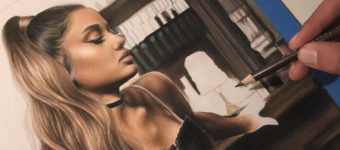
How To Draw Comics: Free Video Tutorials For Beginners
If you read comics you’ve probably thought of drawing them yourself.
But where do you even start? What materials should you use?
How do you write a script?
How long should your comic be? What art style should you use? Would you prefer the genre of action/storytelling or more of a funny webcomic?
Trying out a new art form can feel really overwhelming at first, and if you’re brand new to art comics can be even tougher to dive into.
But these are some of our favorite video tutorials for comic art newbies so if you’re looking for guidance on making comics this list should help you out.
How To Start Your Comic
Sometimes the hardest part of starting…is getting started. Where DO you start with an idea for a comic, anyway?
There’s a lot that goes into creating a comic before you even draw your first panel. But this tutorial breaks everything down for you so you know what to do first, next, and after that.
This video walks you through the process of getting inspiration for your comic, organizing your ideas, writing a script, planning your panels, and designing characters and worlds.
Sometimes just knowing the order in which to do things is really helpful if you have no idea where to start.
And that’s exactly why this tutorial should end up in your browser bookmarks.
How To Compose Comic Book Pages
This handy video guide shows how to create your panels and tell a story in a visual format.
In this tutorial you learn how your story can influence your layout so that they complement each other. You’ll also play with different kinds of establishing shots and methods of conveying information visually.
Your layout gives your readers more information and enhances your storytelling. Of course, you could just do four panels straight across the page but why not play with your layout a bit?
It’s fun to watch an artist sketch their panels and you’ll probably think up some great ideas for your own panels along the way.
Sea Rabbit – Make A Webcomic
Here’s a fun animation to help you get some ideas and plan out your comic before you start drawing.
Coming up with solid ideas that seem random is harder than you think. So this tutorial will also give you tips for developing your style without copying directly (because come on, stick figures and talking heads are kind of overdone).
You’ll even get a quick rundown of how to publish your comics online.
This video is only a couple minutes long so this is a great one to jump in if you’re feeling overwhelmed, or if you just want a quick overview before you start focusing on the details.
This also works best if you’re planning on drawing shorter comics without an ongoing story or complex characters.
If you’re interested in one-off funny comics this is a great starting point.
How To Make Comics (Pt 1)
So here we’ve got the first of a two-part series where artist Mark Crilley creates a few comic panels from start to finish for his graphic novels.
Mark starts by writing the script and planning out his panels by hand, then he pencils the comic traditionally on paper.
It’s fun to see how loose and rough this process can be, and sometimes watching someone create from start to finish is the best way to learn.
Make sure to watch the next video if you want to see Mark ink and color his comic too.
Comic Time-Saving Tips
This is true for pretty much all art, but creating comics can be really time consuming. Especially when you’re just getting started.
This artist Lars Martinson learned about time economy the hard way: while his graphic novels are beautiful, he realized that he could have saved a ton of time without sacrificing artistic quality.
These are just a few smart tips that you can apply to just about anything, especially making comics.
Lars shares those tips in this video so you don’t make the same mistakes.
It’s all about picking which corners to cut that won’t negatively affect the reader’s experience. Trust me, when you know where to focus your attention your reader won’t even notice your shortcuts.
How to Draw Comic Strips
This is a simple tutorial to help you jump in with drawing your first comic strip. You’ll watch the artist draw a simple strip in about 5 minutes flat.
This video is actually about drawing while some of these others are more about planning, so make sure to plan your comic first before watching this one.
With any form of art or writing it’s easy to get stuck in the planning stages, but this is particularly troublesome in comics.
If anything, this video is an invitation to get out of the planning phase already and spend a few minutes actually drawing.
So if you haven’t started drawing yet I’d say it’s time to draw your first comic!
Write & Draw Comics
This video is the first in a ten-part series that covers every aspect of creating comics. If you’re in the mood for a long, comprehensive training series on comics(totally free) well then uh, here ya go.
This first video helps you create your story which is the backbone of any comic.
Your story might be complex or very simple, but you really can’t just jump in and start drawing without a plan.
This video offers a deeper look at storytelling and creating a story, so if your comics are going to have a plot and complex characters make sure to watch this first part at least.
You’ll get some do’s and don’ts for planning a story and writing a script, and how to get over the ever-so-common fear of the blank page.
You’ll learn about mind-mapping and brainstorming stories and some tips to avoid linear progressions that feel boring or dull.
Find Your Comic Book Art Style
Your style is what sets your comics apart from everyone else.
But how do you find your style?
This video offers a few tips for creating your own style without copying others, but still using others for artistic inspiration.
Collect inspiration and references, improve your drawing skills, develop a visual library and figure out what you like about other people’s work that you can incorporate into your own.
There are comics out there in every style from stick figures to punchy superhero cartoons to realistic, meticulously rendered graphic novels.
However you like to draw, it can work in a comic.
Planning Your Comic Panels
Watch YouTuber Whyt Manga create characters and plan out panels for this assignment from a Skillshare course.
It’s really helpful to watch the entire process before you try it yourself so you can see how someone else deals with artistic choices and potential blocks.
He shows you the whole process from start to finish and how he wrote his script, planned his panels, and made those bigger creative decisions.
How To Make Comics: Backgrounds
Some of the most breathtaking illustrations in comic books involve gorgeous backgrounds.
You know those beautiful, full-page wide shots? Those are great for establishing location which is important if your comic has a continuing plot.
This artist shares tips for creating memorable backgrounds where they count. You’ll see interiors, exteriors, simple backgrounds, and complex establishing shots that all look unique.
You’ll also learn about lighting and how to simplify backgrounds so you aren’t spending tons of time on every panel (remember that time saving video earlier?)
Characters and dialogue are the stars of comics. But don’t forget backgrounds since they’re just as important.
Tips on Writing Comics
Art is just one side of the coin when it comes to comics. The other is writing.
This artist shares her tips on writing for comics. Unlike other tutorials you might see she recommends you start with characters, not plot or dialogue.
She shares these tips in voice over as she inks comics which makes the video all the more fun.
You’ll learn techniques for writing comics, writing in general, and what makes a well-written character.
The focus here is all about developing characters so the story can come from them, and not the other way around.
Later in the video she also goes over questions to help you get to know your characters and draw your character’s personality from your imagination.
Comics in Procreate From Start to Finish
We published a massive list of Procreate tutorials that can help you pick up this incredible program. But learning to design a comic in Procreate is a whole new ballgame.
Here the artist starts by selecting his canvas size, drawing panels, inking, and lettering all in Procreate.
Note that Procreate isn’t made specifically for comics, so some parts do get a little awkward. But this video shows you how to do the whole process and overcome any limitations the app might have.
And it’s fun to watch this comic come together!
If you’re planning on drawing comics in Procreate or using Procreate for any part of the process then you’ll learn a whole lot from this tutorial.
Speed Draw: Sun-Burn
Enjoy this speed drawing video of the process of digitally creating a short comic, from setting up the panels to drawing and coloring.
The artist also shares tips for getting ideas for comics and writing jokes for funny comics.
There aren’t a lot of videos about coloring on this list so make sure to watch this one.
The colors are very simple but they do their job. Colors don’t have to be complicated!
DC Comics Art Academy Featuring Jim Lee
Watch pro comic book veteran Jim Lee give this incredible tutorial at Comic Con 2015.
While hand-drawing his characters he sprinkles in tips like how to draw hair without rendering every strand, smudging ink for background shading, tips for drawing hands, and other suggestions for drawing in a classic superhero style.
It’s fascinating to watch a master at work. He uses many different tools and techniques you might never think to use on your own!
Comic Page From A to Z in Krita
This is a long video(over an hour and a half!) but it’s a good watch if you’re interested in using Krita to create comics, or if you just want to watch the creation of a beautifully rendered and colored comic from start to finish.
The artist starts with a messy sketch to plan out his panels, then refines his lines, tones, inks, and colors, entirely in Krita.
This video is one part speedpaint and one part tutorial with the artist popping in to explain what he’s doing, and then speeding things up as he shades, colors, and paints highlights.
It’s long for sure. But it’s worth your time to see the whole process come together.
Although if you practice a lot and watch a ton of tutorials, all while reading plenty of comics for inspiration, you’ll be creating your own incredible comics in no time.











